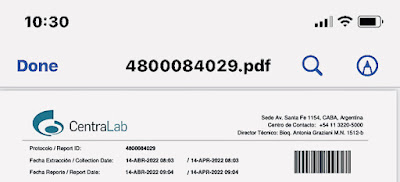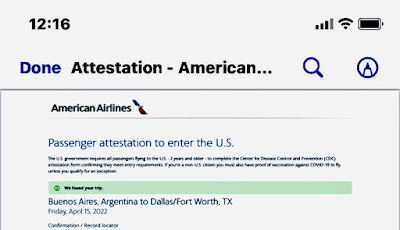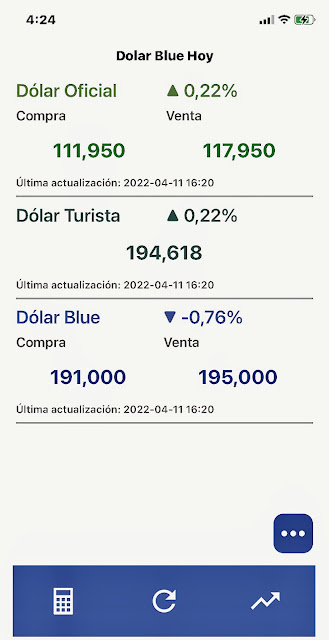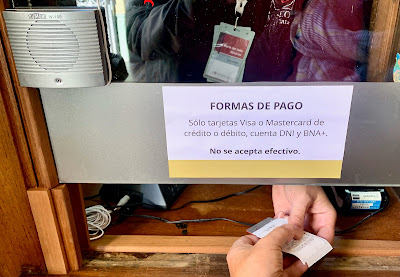Early last week, anticipating our flight back to California (via Dallas), we rose early and went to the closest location of CentraLab, a private medical testing company in Buenos Aires. To return to the US, being fully vaccinated against COVID-19 is still insufficient to return; it requires either a PCR or an antigen test the day before flying. It’s worth noting that this is not a 24-hour requirement; our flight was scheduled for 8 p.m. Friday evening, but any time on Thursday would have been acceptable.
 |
| Results of the antigen test (with personal info edited out) |
 |
| The obligatory attestation... |
We were hoping to be able to schedule the tests there, but that location did not handle COVID testing. Rather, they said, we would have to schedule an appointment online for a different venue—but one that was still only a US$2 cab ride from our apartment. If our appointment hadn’t been at 8:45 a.m., we’d have walked there but, as it was, we got there shortly after 8 and they saw us almost immediately. In just two hours we received the results and could relax. After filling out the obligatory attestation for US immigration, we finished our last full day with an Italian dinner, with my brother-in-law and his wife, at Trattoria Olivetti (its walls decorated with typewriters), just across the street from our place.
 |
| The exterior of Olivetti |
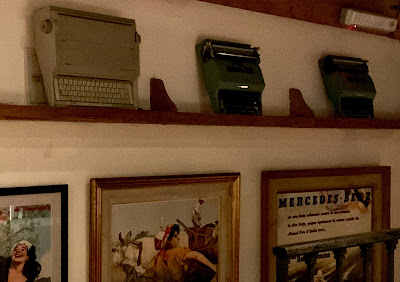 |
| And the interior... |
The next afternoon, getting to the airport was a bit more complex than we anticipated. Leaving the apartment, we immediately caught a cab to the central Terminal Madero in the expectation of catching a Tienda León remise (livery car) to Aeropuerto Internacional Ministro Pistarini (aka Ezeiza). Because there were two of us, this would be only marginally more expensive than taking the bus, but on arrival we learned that there were no longer any remises operating at the site. The only option was the bus, for which we would have to wait nearly an hour, so we opted for catching another taxi in the street, for which we paid Ar$6000 including tolls.
That was more than the Ar$3820 (US$35.32) I had paid for a remise from the airport a month earlier because, lacking sufficient Argentine cash, I had to use my US credit card. In this later instance, though, I paid with “blue dollar” pesos which made the cost US$34.31 for the two of us (had we taken the first taxi all the way from our apartment, it would’ve been cheaper yet).
Arriving at Ezeiza, we found a fairly long line for our American Airlines flight to DFW, where we would have a four-hour layover before connecting to San Francisco, but we got through immigration and security quickly—or did we? While I used to enjoy flying, I’ve grown to loathe airports but I have appreciated the fact that, in Buenos Aires, we don’t have to remove our shoes and all the electronics from our carry-ons.
 |
| This guy's 2008 visit to Buenos Aires didn't go over well. |
I spoke too soon, though—when we lined up to board the flight, I found myself randomly (?) singled out for a secondary check that did involve removing my shoes and my electronics, and even inspecting my iPad for, apparently, traces of explosives. For this I blame the individual in the photo above who, until 2017, was the worst president in my country’s history. He and others of his party have done lasting damage both domestically and internationally.
 |
| We didn't get much flight information... |
Last month’s flight from DFW to Argentina was, without question, my worst experience ever in the air, and one I didn’t care to repeat. Here, though, my initial impression was positive as the Boeing 787 sported a great-looking touch screen for entertainment, but that didn’t last long. For some time, according to the electronic in-flight map on which I normally enjoy watching the plane’s progress, we never left the ground and the hour never changed from 7:53 p.m—“distance to destination 0 km, time to destination 0 minutes.” Eventually a rotating globe appeared, but it soon showed us off the coast of West Africa, approaching the Ivory Coast port of Abidjan!
That, of course, did not inspire confidence, and things got worse as it became apparent that the overhead reading lights did not work in any section of the plane, and to read my paperback novel I had to hold my phone’s flashlight with the book in my lap. Meanwhile, the in-flight food offerings were so unappetizing that I consumed nothing but water. Mercifully, I managed to fall asleep for about a third of the ten-hour ordeal and, when we arrived in Dallas, we passed quickly through immigration and customs, with not even a perfunctory look at our baggage.
So, this flight wasn’t quite so bad as the previous one but, that said, we were now in COVID-friendly Texas where, despite the ongoing mask mandate in airports, at least a third of all passengers couldn’t be bothered about spreading a potentially deadly disease. Fasting to avoid contributing even a penny to this dysfunctional state, we waited at our gate only to learn that a last minute change would require us to sprint more than a mile through the sprawling terminal. Texas is the new Purgatory, and it was a relief to board a flight to the comfort and safety of California.
